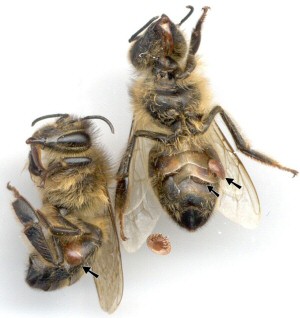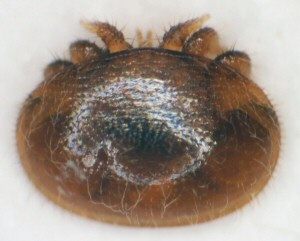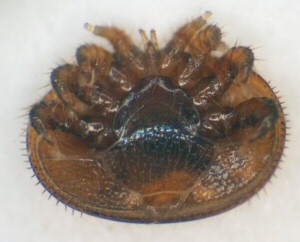Varroa Mite on Honey Bees
 Scientific Name
Scientific Name
Varroa destructor
Hosts
The Varroa mite is an external parasite of honey bees that attacks adult bees and their developing larvae, or brood. It causes decreased brood, deformed bees, and a general weakening of the entire colony. The mite can spread quickly to other bee colonies by traveling with swarms or migrating drones, and by the movement of infested equipment. It is not harmful to humans or livestock.Varroa mites were formerly found only in Asia, Europe, Africa, and South America. In September 1987 they were discovered for the first time in the United States in a Wisconsin apiary.
 Symptoms
Symptoms
A bee colony in the early stages of Varroa infestation may not show evidence of the mites, but parasitized colonies become weaker as the mites multiply. In later stages, young bees may have several mites attached, usually between the overlapping segments of the abdomen. As a colony becomes heavily infested, as many as 10 mites may infest a single bee.Heavy infestations can be diagnosed by Varroa feces on the insides of cells from which parasitized bees have emerged. Brood combs also show dead bee larvae and pupae in various stages of decay. The mites can be seen on the bees and on brood taken out of uncapped cells.
 Life Cycle
Life Cycle
Female mites lay up to 12 eggs in a bee brood cell. Nymphal stages of the mite feed
on immature bees. After the mites mature, females are fertilized and the males die.
Female mites may then attach themselves to adult bees. Older female mites may move
from one brood cell to another, continually feeding and laying eggs. During their
life span, adult female mites continue to feed on adult bees. The female mites eventually
migrate to bee larvae in brood cells that are about to be sealed. There, the mites
lay eggs and renew the life cycle. In summer, female mites can live for about two
months. Later in the year they can live for up to eight months, surviving the winter
with clustered bees.
Description: The mites are dark red-brown and measure .04-.08 inches wide., about
one-fourth the size of a rice grain.
Control
Please contact your local county extension office for current information.



